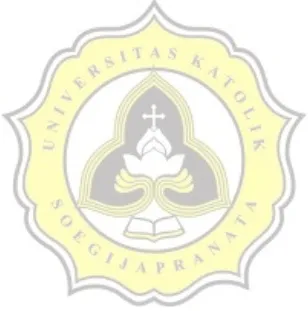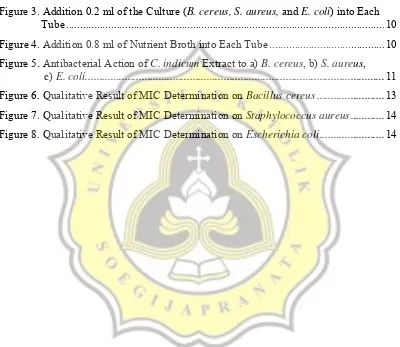MINIMUM INHIBITORY CONCENTRATION (MIC)
EVALUATION OF
Chrysanthemum indicum
EXTRACT ON
Bacillus cereus, Staphylococcus aureus,
AND
Staphylococcus aureus
EVALUASI KADAR HAMBAT MINIMUM (KHM) DARI
EKSTRAK Chrysanthemum indicum PADA Bacillus cereus,
Staphylococcus aureus, DAN Escherichia coli
THESIS
Submitted to The Faculty of Agricultural Technology in partial fulfillment of the requirements for obtaining the Bachelor Degree
By:
CHRISTINA VANIA UTAMI ADI NUGROHO 08.70.0040
DEPARTMENT OF FOOD TECHNOLOGY
FACULTY OF AGRICULTURAL TECHNOLOGY
SOEGIJAPRANATA CATHOLIC UNIVERSITY
SEMARANG
2012
MINIMUM INHIBITORY CONCENTRATION (MIC)
EVALUATION OF
Chrysanthemum indicum
EXTRACT ON
Bacillus cereus, Staphylococcus aureus,
AND
Staphylococcus aureus
EVALUASI KADAR HAMBAT MINIMUM (KHM) DARI
EKSTRAK Chrysanthemum indicum PADA Bacillus cereus,
Staphylococcus aureus, DAN Escherichia coli
By:
CHRISTINA VANIA UTAMI ADI NUGROHO NIM: 08.70.0040
Department: Food Technology
This thesis has been approved and defended in front of the examination committee on July 2012
Semarang, July 2012
Faculty of Agricultural Technology
Soegijapranata Catholic University
Supervisor I Dean
Ir. Lindayani, MP., PhD. Ita Sulistyawati, STP., MSc.
Supervisor II
Dra. Laksmi Hartayanie, MP.
i
SUMMARY
The classic food preservatives methods are heating, freezing, and salting in order to get rid of food spoilage and food pathogenic microorganisms for safety of consumer. Some of food-borne pathogenic bacteria, Bacillus cereus, Staphylococcus aureus, and
Escherichia coli, have extraordinary ability to survive, grow, and proliferate in these classic preservation methods. Thus, a new choice of food preservation method by using the natural antibacterial might be an alternative to solve this problem. Chrysanthemum indicum was chosen in this study for the antibacterial activity on B. cereus,S. aureus,
and E. coli by agar disc diffusion method. C. indicum herbs were extracted and diluted for 100 mg/ml in 95% ethanol. The antibacterial were applied in plates of three bacteria, together with Cloracef as the positive control and 95% ethanol as the negative control. MIC evaluation was done by diluting several concentrations of crude extract in 95% ethanol (50 µl/ml, 25 µl/ml, 12.5 µl/ml, 6.25 µl/ml, 3.12 µl/ml, 1.56 µl/ml, and 0.78 µl/ml) together with Nutrient Broth. All of them was inoculated by 100 µl culture (OD600 =0.1) and incubated for overnight. The lowest concentration of crude extract which can inhibit growth of bacteria was MIC. The aim of this study were to compare the effectiveness of C. indicum antibacterial activity on B. cereus,S. aureus, and E. coli,
and also determine the Minimum Inhibitory Concentration (MIC) of the extract on all bacteria. The result showed C. indicum extract antibacterial activity could inhibit the growth of B. cereus, S. aureus, and E. coli with the clear zone was 15 mm, 15 mm, and 14 mm respectively. The lowest concentration that still can inhibit the bacteria growth (MIC) quantitatively was 6.25 µg/ml for all bacteria. Qualitatively, B. cereus and S. aureus showed the same MIC, which was on concentration 3.12 µg/ml, while the MIC for E. coli was 6.25 µg/ml.
ii
RINGKASAN
Beberapa contoh metode pengawetan tradisional adalah pemanasan, pendinginan, dan penggaraman dengan tujuan untuk menghilangkan mikroorganisme patogen pada makanan agar aman dikonsumsi. Bakteri patogen yang sering mengontaminasi makanan, seperti B. cereus, S. aureus, dan E. coli, mempunyai kemampuan lebih untuk bertahan, tumbuh, dan berkembang biak pada metode pengawetan tradisional tersebut. Oleh karena itu, metode pengawetan makanan baru menggunakan antibakteri alami menjadi salah satu alternatif untuk menyelesaikan masalah tersebut. Chrysanthemum indicum dipilih dalam penelitian ini untuk aktivitas antibakteri pada B. cereus, S. aureus, dan E. coli dengan metode agar disc diffusion. C. indicum diekstrak dan dilarutkan pada etanol 95% untuk konsentrasi 100 mg/ml. Antibakteri tersebut diaplikasikan pada cawan petri berisi tiga jenis bakteri tadi, bersama dengan Cloracef sebagai kontrol positif dan etanol 95% sebagai kontrol negatif. Evaluasi KHM (Kadar Hambat Minimum) dilakukan dengan melarutkan beberapa konsentrasi ekstrak dalam etanol 95% (50 µl/ml, 25 µl/ml, 12.5 µl/ml, 6.25 µl/ml, 3.12 µl/ml, 1.56 µl/ml, and 0.78 µl/ml) bersama dengan Nutrient Broth. Semuanya diinokulasi dengan 100 µl kultur (OD600 =0.1) dan diinkubasi semalam. Konsentrasi ekstrak terendah yang masih dapat menghambat pertumbuhan bakteri adalah KHM. Tujuan dari penelitian ini adalah untuk membandingkan efektivitas antibakteri C. indicum terhadap B. cereus, S. aureus, dan E. coli, dan juga menentukan Kadar Hambat Minimum (KHM) ekstrak untuk ketiga bakteri. Hasilnya adalah ekstrak C. indicum mempunyai aktivitas antibakteri yang dapat menghambat pertumbuhan ketiga bakteri dengan zona bening berurutan 15 mm, 15 mm, dan 14 mm. Konsentrasi terendah yang masih dapat menghambat pertumbuhan bakteri (KHM) secara kualitatif adalah 6.25 µg/ml untuk semua bakteri. Secara kualitatif,
B. cereus dan S. aureus menunjukkan KHM yang sama, yaitu 3.12 µg/ml, sedangkan KHM untuk E. coli adalah 6.25 µg/ml.
iii
PREFACE
Thanks to Lord Jesus Christ for His Amazing Guidance and Wonderful Blessing so that finally I can finish this thesis entitled “MINIMUM INHIBITORY CONCENTRATION (MIC) EVALUATION OF C. indicum EXTRACT ON B. cereus, E. coli, AND
S. aureus”. This thesis is submitted to the Faculty of Agricultural Technology in partial fulfillment of the requirements for obtaining the Bachelor Degree.
There is so much new knowledge and experiences had been acknowledged during the research, particularly on the science and scientific writing. This thesis can be done by assistance from some individuals who always give their best support that I very grateful for. Without them, I would not have done this thesis. I would like to gratefully acknowledge those great individuals:
1. Mrs. Ita Sulistyawati, STP., MSc., as the Dean of Agricultural Technology Faculty of Soegijapranata Catholic University Semarang.
2. Ir. Lindayani, MP., PhD. and Dra. Laksmi Hartayanie, MP., as the supervisors who are being patience in educating and being great teachers for me.
3. Dr. Patchanee Yasurin from Biotechnology Department of Assumption University, Bangkok, as the supervisor during student exchange program who introduces me to this biotechnology research.
4. My family: father, mother, brother, sister, for being the best family that always give full supports, time and patience in awaiting me to reach the best goals of life. 5. Hendra, as the sweetest person in the writer’s life, for an unlimited assistance during
the report compilation. I always get a place to cheer on and cry on that empowering to keep struggle with this life process.
6. Ms. Endah and Mr. Soleh as the laboratory assistants for huge endurance during the lab days.
7. My beloved FTP’s lecturers for inspiring the writer with so many invaluable provisions.
8. Valentine Community: Fefe, Dessy, Nana, Ira, Silvi, Karin for encouraging the writer much. We are friends now and forever.
iv
9. All other people, who cannot be possibly mentioned one by one, who made this thesis can finally be finished with their kindness and support.
I realize that this thesis report is still far from perfect. I am open to any advice and criticism for the improvement of this report. I truly hope that this research could give a valuable contribution in the world of science and be useful to the development of food industries.
Semarang, July 2012
Author,
Christina Vania Utami Adi Nugroho
v
1.2. Literature Review ... 2
1.2.1. Bacillus cereus, Escherichia coli, and Staphylococcus aureus as Pathogenic Bacteria ... 2
1.2.2. Chrysanthemum indicum and Clorasef as Antibacteria ... 3
1.2.3. Extraction, Disc Diffusion and MIC Methods ... 5
1.3.Aim of the Research ... 6
2. MATERIALS AND METHODS ... 7
2.1.Time and Place of the Experiment ... 7
2.2.Material ... 7
2.3.Methods ... 7
2.3.1. Preliminary Research ... 7
2.3.1.1.The Making of C. indicum Antibacterial ... 7
2.3.1.2.Preparation of Modified Disc ... 8
2.3.1.3.Preparation of the Culture ... 8
2.3.1.4.Agar Disc Diffusion Method ... 8
2.3.2. Primary Research ... 8
2.3.2.1.Preparation of Antibacterial... 8
4.1.The Antibacterial Activity as Clear Zone of Chrysanthemum indicum Extract on Bacillus cereus, Staphylococcus aureus, and Escherichia coli .... 16
4.2.Minimum Inhibitory Concentration (MIC) Determination of C. indicum Extract on B. cereus, S. aureus, and E. coli ... 17
4.2.1. Quantitative Test of MIC Determination ... 18
4.2.2. Qualitative Test of MIC Determination ... 18
5. CONCLUSIONS AND SUGGESTIONS FOR FUTURE WORK ... 20
5.1.Conclusions ... 20
5.2.Suggestions for Future Work ... 20
6. REFERENCES ... 21
vi
LIST OF TABLES
page Table 1. Antibacterial Action of the Crude Extract of C. indicum to B.cereus,
S. aureus, and E. coli ... 11 Table 2. MIC Determination by Quantitative Test of C. indicum
Extract on B. cereus, S. aureus, and E. coli ... 12 Table 3. MIC Determination by Qualitatitve Test of C. indicum
Extract on B. cereus, S. aureus, and E. coli ... 13
vii
LIST OF FIGURES
page
Figure 1. C. indicum Dried Herbs (Private Documentation) ... 8
Figure 2. Preparation of the C. indicum Antibacterial into Seven Concentrations (50 µg/ml; 25 µg/ml; 12.5 µg/ml; 6.25 µg/ml; 3.12 µg/ml; 1.56 µg/ml; 0.78 µg/ml) ... 9
Figure 3. Addition 0.2 ml of the Culture (B. cereus, S. aureus, and E. coli) into Each Tube ... 10
Figure 4. Addition 0.8 ml of Nutrient Broth into Each Tube ... 10
Figure 5. Antibacterial Action of C. indicum Extract to a) B. cereus, b) S. aureus, c) E. coli ... 11
Figure 6. Qualitative Result of MIC Determination on Bacillus cereus ... 13
Figure 7. Qualitative Result of MIC Determination on Staphylococcus aureus ... 14
Figure 8. Qualitative Result of MIC Determination on Escherichia coli ... 14

